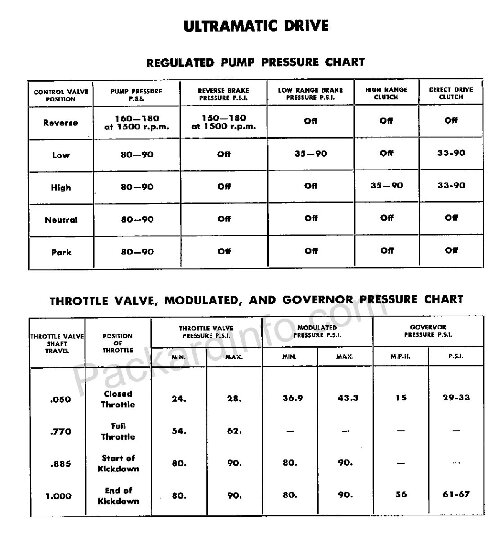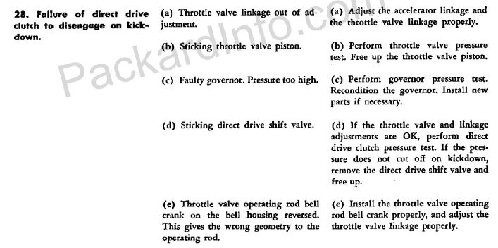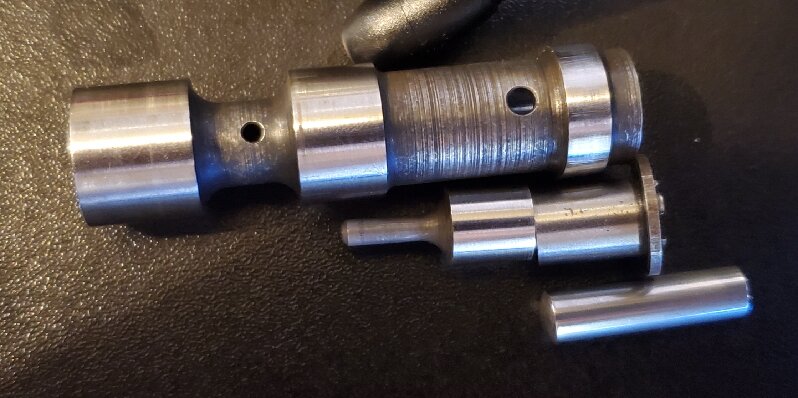|
Re: Direct Drive Clutch not opening on Throttle Input ('54 non-gear-start type)
|
||||
|---|---|---|---|---|
|
Home away from home
|
I would increase your throttle pressure adjustment slightly and see if it helps.
By the way, who is this Ultramatic mechanic in Sweden you are talking to? What else changed during the rebuild? If the small parts of the direct shift valve are jammed with grime, but the valve as a whole slides back and forth, the hysteresis functionality will be lost.
Posted on: 2024/9/18 5:06
|
|||
|
1955 400 | Registry | Project Blog
1955 Clipper Deluxe | Registry | Project Blog 1955 Clipper Super Panama | Registry Email (Parts/service inquiries only, please. Post all questions on the forum.) service@ultramatic.info |
||||
|
||||
|
Re: Direct Drive Clutch not opening on Throttle Input ('54 non-gear-start type)
|
||||
|---|---|---|---|---|
|
Home away from home
|
Quote:
I had my car out for a couple of hours yesterday, about 100 miles, and I currently have, and think I always have had, the issue you're talking about. The direct drive does not disengage until the car slows to about 11 mph. From what I understand that would be the governor disengaging the direct drive. When I give it throttle the throttle valve should disengage the direct drive at lower speeds, but doesn't..........medium or heavy throttle it doesn't disengage. I had previously adjusted my throttle linkage and valve to factory spec and the direct drive is engaging at appropriate speeds, that is around 20 mph under light acceleration and 40 mph under heavier acceleration. Now I'm embarking on rebuilding the transmission from my parts car to do a swap in the spring so I have a fresh transmission with clutch plates made of modern materials, but I amy curious as to why my direct drive is acting the same as yours. I tried giving it heavy throttle for several seconds in the event it was just slow to relieve pressure, and would eventually disengage, but no such luck. The direct drive just doesn't disengage until the car slows down to around 11 mph. I have not checked pressures at all, and will probably not go to the trouble with this transmission considering I'm rebuilding the other.
Posted on: 2024/9/18 11:13
|
|||
|
||||
|
Re: Direct Drive Clutch not opening on Throttle Input ('54 non-gear-start type)
|
||||
|---|---|---|---|---|
|
Not too shy to talk

|
Cordial thanks to Humanpotatohybrid and Cavalier 53 for your replies. Very sobering to hear that the 53 basically behaves in the same akward manner as mine. If this is "normal operation", than it is no wonder that Packard only sold 30 000 cars in 1954. Wait with the rebuild until we have solved the enigma, if we can.
I actually have diverted from the shop manual pocedure for adjusting the throttle valve lever at the rear right side of the transmission. I adjusted the throttle valve lever about 20 deg further to the rear than specified in the shop manual. In this position the hole in the lever will not align with the fork at the lower end of the relay rod when the throttle valve lever is at its rear stop. The lever needs to be pulled forward ca 20 deg to fit the clevis pin . This means that the throttle valve is somewhat open at idle. This way, the valve supplies pressure earlier and restricts pressure later than with the position specified in the shop manual. The effect is that the lock-up occurs 10 mph later on acceleration, 30-35 mph at light load (not really desired) and opens earlier, at 16 mph (vs 11 mph) at roll-out, which is better, but not good enough. DD will still not open when I try to accelerate at 17 mph. Thus, cheating the clutch control valve by some pre-opening of the throttle valve somewhat improves driveability but does not solve the fundamental problem: Closing and opening of the lock-up should be variable, depending on car/engine speed and engine load. Not just depending on engine speed and brutal Kick-Downs if engine speed is too low. The transmision specialist in Sweden is PS Maskin in Ucklum, Per Svensson, a very recommended and dedicated mechanic. I trust him, but in this paticular case his wisdom ended. Again, looking forward to more wisdom ... Cheers, R
Posted on: 2024/9/18 13:47
|
|||
|
1954 Panama
|
||||
|
||||
|
Re: Direct Drive Clutch not opening on Throttle Input ('54 non-gear-start type)
|
||||
|---|---|---|---|---|
|
Home away from home
|
Roland, good to hear you were able to make the adjustment, but as you can see it has the expected side effects and doesn't fix the problem. What I would suggest you try is to get in the habit where, if you want the direct drive clutch to disengage, quickly press the accelerator pedal to the floor just long enough that the transmission disengages the clutch, then release it most of the way. With some practice, I think you will be able to do this to get out of direct drive, without having a dramatic response from the engine. If you find success with this, you may also be able to adjust the throttle linkage back to the usual position, so that direct drive engages earlier.
I have spoken with other drivers, the other option is to simply not hit the gas too hard, and the engine will sound a little happier. Obvious suggestion, I know. By the way, here is a photo of the valve in question, which will complement my explanation below. P.S. I think your transmission mechanic has quite good knowledge on these, compared to most Packard owners or old car mechanics that do not specialize in Packard.
Posted on: 2024/9/19 7:06
|
|||
|
1955 400 | Registry | Project Blog
1955 Clipper Deluxe | Registry | Project Blog 1955 Clipper Super Panama | Registry Email (Parts/service inquiries only, please. Post all questions on the forum.) service@ultramatic.info |
||||
|
||||
|
Re: Direct Drive Clutch not opening on Throttle Input ('54 non-gear-start type)
|
||||
|---|---|---|---|---|
|
Home away from home
|
Roland, I just spoke with Ross (one of the main Ultramatic mechanics in the USA) abiut this concern. Did your mechanic need to replace the direct drive clutch from the old one being too hard? If so, then there is your answer: the reason it would have felt like it was entering converter drive before, is that your clutch was just slipping.
Posted on: 2024/9/19 7:41
|
|||
|
1955 400 | Registry | Project Blog
1955 Clipper Deluxe | Registry | Project Blog 1955 Clipper Super Panama | Registry Email (Parts/service inquiries only, please. Post all questions on the forum.) service@ultramatic.info |
||||
|
||||
|
Re: Direct Drive Clutch not opening on Throttle Input ('54 non-gear-start type)
|
||||
|---|---|---|---|---|
|
Home away from home
|
Quote:
I had similar discourses with my transmission specialist and he eventually concluded that the problem I have now is normal operation I can tell you that from many, many years of driving Packards with Ultramatic, what you described is not normal!
Posted on: 2024/9/19 15:43
|
|||
|
All generalities are false.
Once I thought I was wrong but I was mistaken. Don Pierson Packard / IMPERIAL page CA DMV Licensed Vehicle VIN Verification 1951 Henney-Packard 3-Door Long Wheelbase Air Force Ambulance The 1951 Henney-Packard is For Sale! 1954 Packard Patrician 1954 Packard Patrician Parts Car 1956 Clipper Custom Sedan |
||||
|
||||
|
Re: Direct Drive Clutch not opening on Throttle Input ('54 non-gear-start type)
|
||||
|---|---|---|---|---|
|
Home away from home
|
Can you elaborate??
Posted on: 2024/9/19 15:53
|
|||
|
1955 400 | Registry | Project Blog
1955 Clipper Deluxe | Registry | Project Blog 1955 Clipper Super Panama | Registry Email (Parts/service inquiries only, please. Post all questions on the forum.) service@ultramatic.info |
||||
|
||||
|
Re: Direct Drive Clutch not opening on Throttle Input ('54 non-gear-start type)
|
||||
|---|---|---|---|---|
|
Home away from home
|
Tell me if I have this correct in my head.
When accelerating, depending on how far the accelerator pedal is depressed, the throttle valve overrides the governor and prevents the direct drive from engaging. Currently on my car the direct drive engages around 20 mph when light on the pedal, and around 40 mph when heavier on the pedal. This seems to funcion fine, and my direct drive engages quite smoothly. But what is not happening, for myself or Ronald, is the throttle valve overriding the governor to disengage the direct drive after it has engaged. It would seem that it is only the governor that is disengaging the direct drive once the car slows to around 11 mph. I understand that at higher speeds the throttle valve will not override the governor. But for example, if the direct drive engages at 20 mph, and then you step on it when going 25 mph, the throttle valve should override the governor and disengage the direct drive. Correct? My question is if the throttle valve is adjusted correctly and is working to keep the direct drive from engaging, what is happening that the throttle valve isn't working to disengage the direct drive? 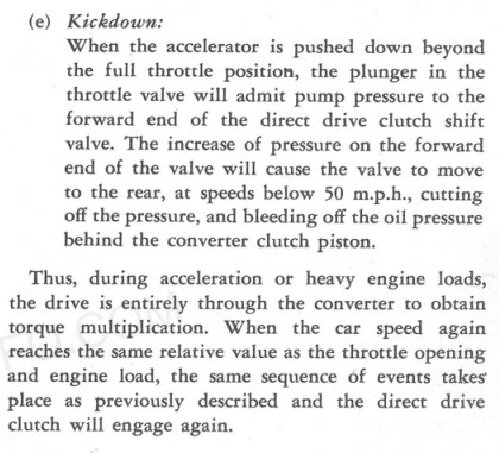
Posted on: 2024/9/19 16:45
|
|||
|
||||
|
Re: Direct Drive Clutch not opening on Throttle Input ('54 non-gear-start type)
|
||||
|---|---|---|---|---|
|
Home away from home
|
When accelerating, depending on how far the accelerator pedal is depressed, the force from the throttle valve pressure on the left side of the direct shift valve exceeds
But what is not happening, for myself or Ronald, is the throttle valve overriding the governor to disengage the direct drive after it has engaged. I understand that at higher speeds the throttle valve will not override the governor. But for example, if the direct drive engages at 20 mph, and then you step on it when going 25 mph, the throttle valve should override the governor and disengage the direct drive. Correct? The force from the throttle valve pressure on the left side of the valve opposes both the governor pressure and the modulated pressure, which both work to push the valve to the right. So if by "step on it" you mean floor it, then yes. Otherwise, no. My question is if the throttle valve is adjusted correctly and is working to keep the direct drive from engaging, what is happening that the throttle valve isn't working to disengage the direct drive? Because the valve is designed to have hysteresis, so that when the direct drive clutch is engaged, the forces acting on the valve body are different than when it is disengaged, as detailed earlier. ---------------------------------------------------------------------------------------------------------------------------------------------------------- I made a chart to help illustrate this. X is throttle pressure and Y is governor pressure. Direct drive engages when you move above the red line. It disengages when you move below the orange line. The blue dashed lines are the limits of throttle pressure. The purple dashed lines are the limits of governor pressure. The green dotted line indicates full throttle (beyond which is kickdown). The second graph below indicates accelerator position relative to throttle pressure; note the immediate jump into the kickdown region. Approximate speed values are given for the governor pressures on the left. The numbers on this chart are pulled directly from my calculations in my previous post. Let's say you are starting off from a stop with half throttle. This is shown in the pale pink line. Throttle position steady at 40 PSI as governor pressure climbs. Once you get to 40 PSI governor, you enter direct drive. In this example we keep speeding up to 56 PSI governor then let off the gas a sec. We floor it (medium pink) and nothing happens. We coast a bit (magenta) then floor it again (purple). This time, we are going slow enough to kick down. Again we let off the gas (royal blue) and coast down to about 15 MPH. But again, we find that we need to hit kickdown to get out of direct (medium blue). We can also see that if we slow down any more, the governor pressure drops out, so any throttle pressure will be below the orange line, and disengagement is guaranteed (not shown by arrow). P.S. The second graph is just a clean version of the first graph. P.P.S. If it's not already clear, that kickdown explanation is just saying that one you press farther than full throttle, it just maxes out the throttle pressure. (= pump pressure) Attach file:  Screenshot 2024-09-19 210617 (2).jpg (249.71 KB) Screenshot 2024-09-19 210617 (2).jpg (249.71 KB)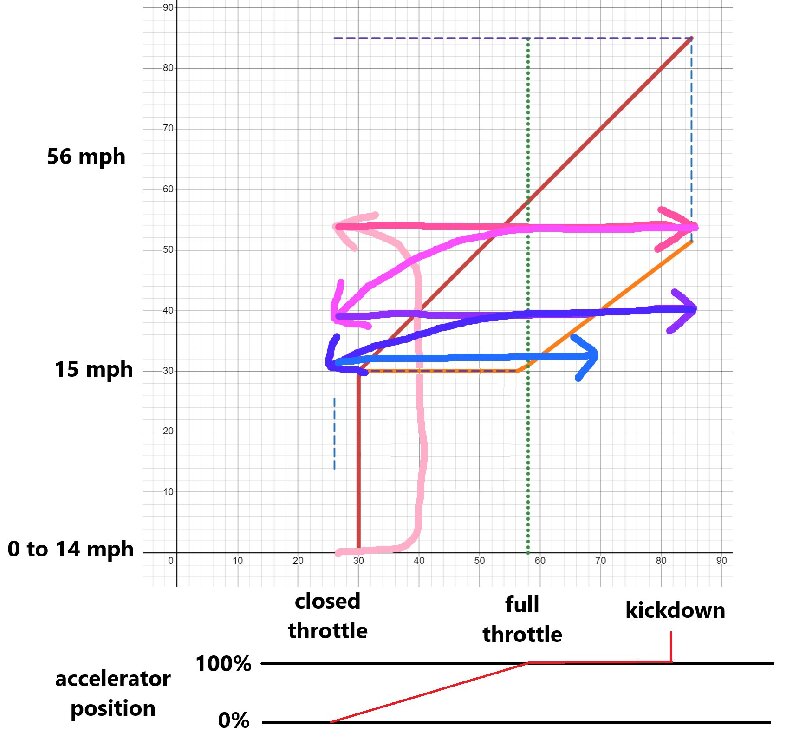  Screenshot 2024-09-19 213751.jpg (174.80 KB) Screenshot 2024-09-19 213751.jpg (174.80 KB)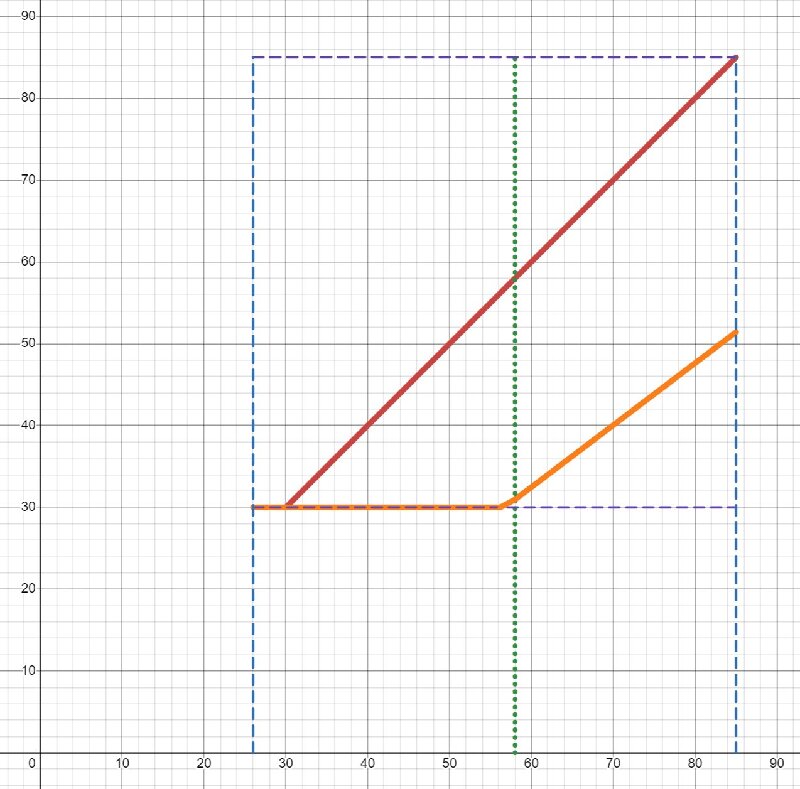
Posted on: 2024/9/19 20:25
|
|||
|
1955 400 | Registry | Project Blog
1955 Clipper Deluxe | Registry | Project Blog 1955 Clipper Super Panama | Registry Email (Parts/service inquiries only, please. Post all questions on the forum.) service@ultramatic.info |
||||
|
||||


